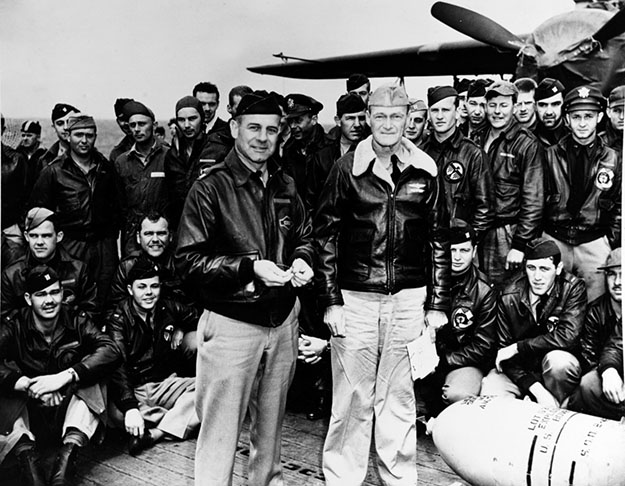JOINT BASE LEWIS-MCCHORD -On a Pacific Northwest winter day in early 1942, a U.S. Army Air Force Lieutenant Colonel came to McChord Air Force Base searching for a few good men from the 17th Bombardment Group to join him on a secret mission. The mission would not be easy and there was a good chance they could die, but they would bring pride to their nation.
After the Japanese attacked Pearl Harbor on December 7, 1941; President Franklin D. Roosevelt tasked the U.S. military to devise a retaliatory attack plan against the Empire of Japan. Capt. Francis S. Low, Assistant Chief of Staff for antisubmarine warfare, suggested launching bombers off an aircraft carrier to bomb Japan. The president and the Joint Chiefs of Staff quickly accepted the plan.
Military leaders selected Lt. Col. James Doolittle to organize and lead the mission. Due to its cruising range and bomb load capacity, Doolittle and planners of the mission chose the B-25 Mitchell to carry out the mission and began trial runs to launch a B-25 off the deck of the USS Hornet at Norfolk, Virginia. After a successful test run, mission planners selected the 17th Bombardment Group (Medium) and other groups to provide crews for the secret mission.
The 17th Bombardment Group first arrived at McChord Field on June 24, 1940 and were the first American flying group to receive and train with the B-25 Mitchell. After the test runs in Norfolk, Doolittle came to McChord to search for experienced B-25 crews to volunteer for the bombing mission. At least ten aircrew members who trained at McChord volunteered for this dangerous secret mission.
After three weeks of training at Eglin Air Field, Florida, in March 1942, Doolittle and 24 crews set off from Alameda, California, on the Hornet with 16 B-25s on April 2, 1942. On April 18, at 8:38 a.m., approximately 650 miles from Japan, a Japanese picket boat spotted the Hornet and carrier group and radioed in the position to Japan before the USS Nashville could destroy the vessel. Still 170 nautical miles away from the planned departure site, at 8:20 a.m., Doolittle launched the mission ten hours early rather than losing the element of surprise.
Six hours after the launch, B-25s arrived over Tokyo, Yokohama, Yokosuka, Nagoya, Kobe, and Osaka and bombed 16 military and industry targets. After unloading their bombs, the B-25s flew west toward China. Fifteen of the B-25s crash landed or bailed out over China and the 16th bomber landed in the Soviet Union. Three crew members were killed and eight were taken as prisoners of war by the Japanese. Of these eight POWs, the Japanese executed three, allowed one to die from disease, and American troops liberated the other four in August 1945.
Though the bombings caused minimal physical damage to Japan, the raid dispelled any notions of Japanese invincibility and put the empire on alert. After the tragic losses at Pearl Harbor, the Doolittle Raid significantly increased American morale and inspired a nation into action.





Read Comments